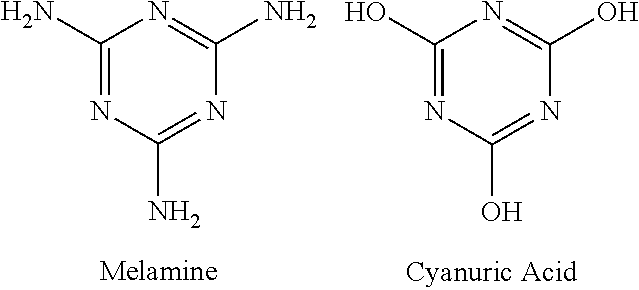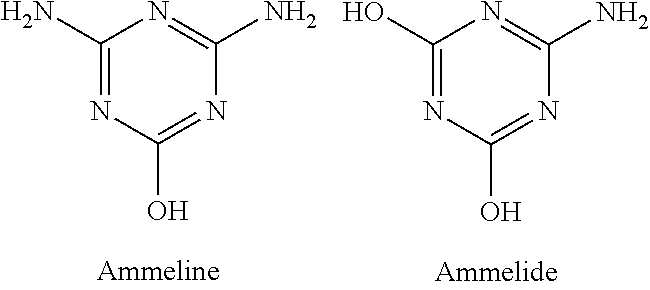Method and system for enzymatic detection of melamine
- Summary
- Abstract
- Description
- Claims
- Application Information
AI Technical Summary
Benefits of technology
Problems solved by technology
Method used
Image
Examples
example 1
Expression and Purification of Recombinant Melamine Deaminase Enzyme
[0035]The TriA gene encoding the melamine deaminase enzyme was inserted into the multiple cloning site region of the pET 24b bacterial expression plasmid. This subcloning strategy places the gene under the transcriptional regulation of the T7 RNA polymerase and fuses a His6 peptide tag onto the C-terminus of the protein to facilitate purification. We expressed the protein (MW about 50 kDa) in E. coli strain BL21 (DE3) and obtained significant amounts of soluble protein in the induced bacterial cultures. After disruption the lysed cell extract was passed over a Talon Cobalt column to bind the His6-tagged protein. After washing the column the bound protein was eluted from the column and dialyzed to remove imidazole. SDS-PAGE analysis indicates that the isolated recombinant protein is highly pure (FIG. 1).
example 2
Enzymatic Detection of Melamine in Microtiter Plates
[0036]Purified, desalted recombinant MDA enzyme (about 2 mg / ml in 0.1 M Na-MOPS buffer pH 7) and melamine (1000 ppm) were diluted into 0.1 M Na-MOPS buffer (pH 7) and incubated overnight (about 12 hours) at room temperature. Reaction aliquots were removed and tested for the production of ammonia by mixing the samples with salicylate / nitroprusside and NaOH / hypochlorite reagents in 96 well microtiter plates. When melamine and enzyme are both present in the wells, a strong color change was observed (FIG. 2), indicating the MDA-mediated conversion of melamine to ammonia in these samples. The observed color change requires the presence of both melamine and MDA enzyme; no color change was observed in wells from samples from control reactions containing only melamine or enzyme alone, indicating that no ammonia is present in these samples.
example 3
Removal of Endogenous Ammonia from Samples
[0037]A 15 ml portion of reconstituted powdered milk was spiked with 5 ppm ammonia (as ammonium chloride). 0.075 ml glacial acetic acid and 10 ml acetonitrile were added to the milk and after mixing, the samples were centrifuged for 10 min at 4,000×g. The supernatants were loaded onto 100 mg Strata X-C cation exchange SPE columns (conditioned with 2 ml methanol and 2 ml 40% acetonitrile / 0.5% acetic acid). The columns were then washed with 2 ml 40% acetonitrile / 0.5% acetic acid, then 2 ml 0.5% acetic acid and then with 2 ml methanol. The samples were eluted from the column with 1 ml methanol containing 0.09 g / ml Na-MOPS plus 0.0009 g / ml MOPS and then 1 ml methanol. After drying off the methanol, the samples were dissolved in 1.5 ml deionized water (approximately 10× concentration of the original 15 ml milk sample). Samples were mixed with salicylate / nitroprusside and NaOH / hypochlorite reagents in microtiter plates to detect ammonia present in...
PUM
 Login to View More
Login to View More Abstract
Description
Claims
Application Information
 Login to View More
Login to View More - R&D
- Intellectual Property
- Life Sciences
- Materials
- Tech Scout
- Unparalleled Data Quality
- Higher Quality Content
- 60% Fewer Hallucinations
Browse by: Latest US Patents, China's latest patents, Technical Efficacy Thesaurus, Application Domain, Technology Topic, Popular Technical Reports.
© 2025 PatSnap. All rights reserved.Legal|Privacy policy|Modern Slavery Act Transparency Statement|Sitemap|About US| Contact US: help@patsnap.com



